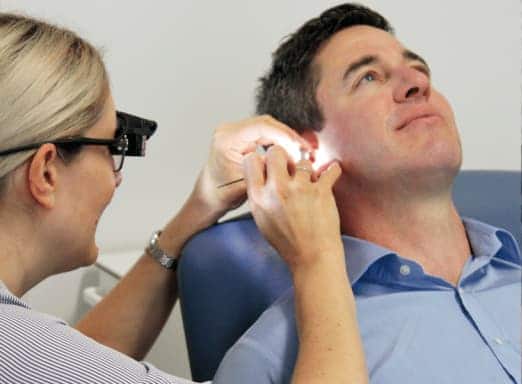Are you suffering from blocked ear symptoms? Do you have blocked sore ears as a result of earwax build up?
All of us have wax in our ears; earwax is an important substance which keeps the ears healthy by lubricating the ear canal and preventing infection. However sometimes we can over-produce earwax, leading to excess wax or earwax impaction.
Here are the symptoms you should be looking out for if you think you might have an ear that is blocked by excess ear wax.

Blocked and Full Feeling Ears
One of the most common symptoms of excess or impacted earwax is a blocked or full sensation inside the ear (1). This feeling can be very uncomfortable. It may feel a bit like pressure inside the ear, like when you take off or land in an airplane. You may be tempted to try to relieve the blocked feeling with your finger, a cotton bud or a ‘twisty topped’ implement, but avoid putting any objects inside the ear. This can potentially cause trauma to the ear canal and drum and cause serious problems.
Itching Ears
There are a few reasons why you might develop itchy ears. Surprisingly, itching inside the ear can be caused by both an excess of earwax that has built up, and a lack of earwax that has caused the skin inside your ears to become dry and itchy. Either way, itching in such a hard to reach spot can be very irritating. Don’t try to use an implement to scratch – go and see an Earworx nurse instead to exclude wax as an issue.
Discharge From The Ear
Ear discharge is a symptoms of excess of earwax (1). If you’ve recently used eardrops to try and relieve your blocked ears, a waxy discharge can be a good sign – it means the excess wax is softening and draining out on its own. If the discharge from your ear is yellow, green or blood stained or is accompanied by pain, this is less likely to be an earwax issue; please seek medical advice.
Odour and Colour Change
Are your ears smelling different or does you earwax seem to be changing in colour? A waxy or watery discharge accompanied by odour may be a sign of wax build up (1). Earwax can start to become smelly when the wax builds up over time. When earwax becomes hard and impacted, it also can change colour and become darker and firmer.
Pain
Anyone who has ever suffered from earache knows how painful and uncomfortable it can be. Our ears are sensitive parts of the body, and pain in this area can impact our quality of life. Impacted earwax can result in pain because of the pressure caused by hard wax pressing on the eardrum. If you’re experiencing prolonged pain, or the pain is accompanied by a fever, you should always seek medical advice.
Tinnitus
Tinnitus is the perception of sound without an external source (2). You may experience ringing or other sound in one or both of your ears. This noise can be bothersome and persistent, and can sound like a buzzing, clicking, hissing or humming. Built up earwax can cause the symptom of tinnitus (1) so excluding wax as an issue can be a good first step.
Loss of Hearing
Reversible loss of hearing is a common symptom of excess earwax (1) that can range from mild to severe. If you have noticed that you’re struggling to hear in conversation or while watching television, it could be caused by a build up of earwax. The wax blocks the ear canal, making it difficult for sound to travel to your eardrum where the hearing chain begins. Where a cross-sectional area of the ear canal is reduced by at least 80%, evidence tells us the hearing will start to diminish (1). .
Dizziness
Our ears are integral to our ability to maintain our balance. If there is an issue with excess earwax, this can cause feelings of dizziness (3).
When To Seek Medical Attention
While excess and impacted earwax is normally not serious, the ears are very delicate and important parts of the body that have to be treated with care. Earwax removal via microsuction and curettage should always be completed by a practitioner who has received practical training in the procedure. All Earworx registered nurses have completed a nationally accredited Earworx Course in Aural Care followed by an extended practical placement to ensure they can work safely around your precious ear canal and drum.
Many of the above symptoms may also indicate a more severe medical condition. If you have extreme pain, bleeding from the ears, or a sudden loss of hearing, you should seek emergency medical care.
Book an Appointment with Award-Winning Earworx
If you think you might be suffering from impacted or excess ear wax, book an ear cleaning appointment with Earworx for treatment by one of our qualified registered nurses.
Find your local Earworx clinic and book an appointment.
- Schwartz et al 2017, Clinical Practice Guideline (Update): Earwax (Cerumen Impaction), Otolaryngology-Head and Neck Surgery Vol 156 (IS) SI-S29
- Tunkel et al 2014, Clinical Practice Guideline: Tinnitus, Otolaryngology-Head and Neck Surgery Vol. 151(2S) S1–S40
- https://my.clevelandclinic.org/health/diseases/14428-ear-wax-buildup–blockage
